The Ultimate Joker Article
Ha Ha Ha
THE ULTIMATE JOKER ARTICLE

CLOWN PRINCE OF CRIME

CLOWN PRINCE OF CRIME
I've been saving it for a very long time. As some of you may know, I'm absolutely fascinated with classic villains and already did an articles on Krang, Darth Vader and others.
I was planning to do a Joker article earlier on, but eventually backed out thinking it's not the time yet, and made a spinoff of the idea instead - an article about the famous "Killing Joke" comic book
After the enormous success of The Dark Knight, the history repeats itself and Joker once again is the most popular villain ever, matching or probably even surpassing the phenomenon of Darth Vader, with the international Jokermania stronger than ever.
Just like it was when I was younger. The history repeats itself as I see, and it's pretty weird to actually experience such thing.
I really wanted to give it all in this article, do my absolute best. After I've read the official Batman:The Complete History book I've also done an additional research in various places, and hope the results will show
So let's get started. To quote the most recent incarnation of this classic supervillain:
"And here we go"
---------------------*1940's*---------------------
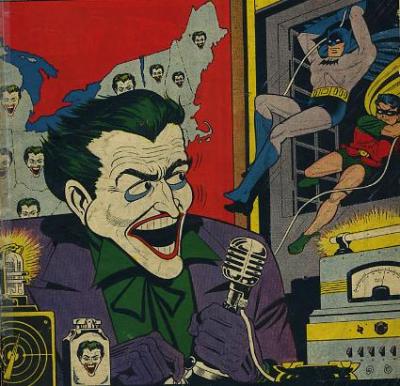

The Joker first appeared in 1940's Batman #1, by Bob Kane and Bill Finger. Those two guys created Batman, not just Bob Kane who is always the only one receiving the credit. Kane created the look and the feel, while Finger created the story and origins. Kane and Finger continued to develop Batman and his world for the next two decades.
Batman was the only superhero who was human and who didn't have any powers, but everything around him was making up for that fact - the villains as oppose to the hero himself were always completely surreal and unreal, and even more outlandish than the alien superheroes from other comic books.
Joker was the first guy in that string of weirdos out of this world. His look was inspired by 1928's movie "The Man Who Laughs"

Although Joker from the beginning was and remained a thief and a crook hungry for money and diamonds for over half of a century, originally in addition to that he was a cold murderer. The story in #1 is way ahead of its time and very suspenseful. Joker announces on the radio that if a certain millionaire will not give him his diamonds, he will die at midnight . Cops and Batman are all over the place guarding the guy, yet when the clock strikes midnight, the rich man falls on the floor and dies. Same thing happens again. It appears that Joker was there two days before and planted a poison that will kill the guy at specific time, leaving a grotesque smile on his victim's dead faces.

Originally, Joker was intended to be killed in the very same issue but the idea was dropped. The editor Ellsworth knew it's too good of a villain to kill him off.
Joker remained unchanged since his creation. Permanent white skin, emerald green hair, red lips, pointy eyebrows, purple eyeshadow and purple gangster suit with stripes and hat. He was a surreal twist on a middle aged cliche 1940's gangster.

Joker's homicidal tendencies were dropped almost immediately. No other changes were made, except for some minor additions. Joker was trying to be a mockery of Batman and started to develop his own gadgets and cars etc. and even more of that in the following decade

Jokerplane and Jokermobile,1946
Even tho the editor saved Joker, the character was killed at least three times in the 40's alone and brought back repeatedly. Then he finally remained an integral part of Batman's universe and an iconic villain he shaped up to be by the end of the 1940's
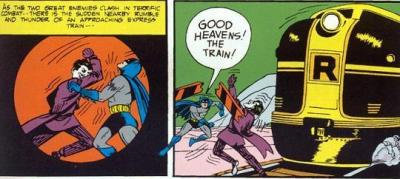
You get the idea what happens next...

-------------------*1950's*-------------------
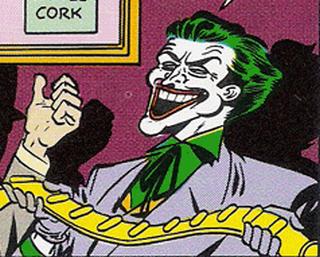

Joker was now Batman's arch-foe and kept appearing in almost every issue of Batman or Detective Comics. He was always this annoying prankster who couldn't help himself but to keep robbing places left and right and getting constantly caught by Batman and Robin.
One of the most famous stories was 1952's "Joker's Millions", where Joker is given a fortune and he doesn't have to steal anymore. Buying numerous cars and mansions, he spends money like crazy until he realizes most of them are fake and has to steal again.
"Joker's Millions" is a perfect example of how innocent Batman stories already were just a decade after his birth. Despite the popular legend about dark roots of Batman, Batman was really dark and gloomy only in the very FEW first issues, even before he got his own comic book. When Batman #1 hit the stores, Robin was already there and Batman was a 'light' blue-ish smiling character
JOKER's GADGETS
1950's saw Joker expanding on his arsenal, which became just as inseparable part of him as were Batman's toys.
Some of Joker's trademark accessories were:
The Utility Belt



The Hand Buzzer

Spitting Flower/Badge/Pin




The Hand Buzzer

Spitting Flower/Badge/Pin

Jokermobile
Also made into a toy and released in different versions numerous times throughout the history. The most known and popular is the Mego version. Here's a panel of Jokermobile from the previous decade
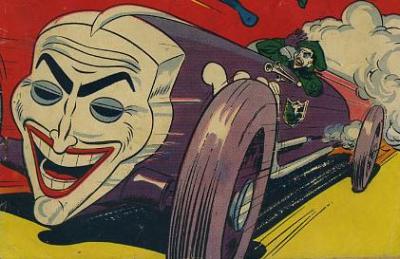
In 1951, Bob Kane and Bill Finger gave us Joker's origins. And here I want to discredit another myth - all villains, and even Batman himself appeared without origins first and then they were given origins some time later. It was a common practice to introduce characters first and expand on those who will stick.
"The Man Behind The Red Hood" was Joker's turn.
The issue tells a story where Batman and Robin are asked to train young detectives/scientists and gave them the assignment that even Batman couldn't solve - the identity of an old villain who disappeared after he fell into pool of chemicals, Red Hood. One of the boys named Paul helped them solve the mystery and the red hood was a lab worker trying to steal a million bucks in a card factory. After his dive into chemicals, he became disfigured and his skin and hair were dyed, introducing The Joker!

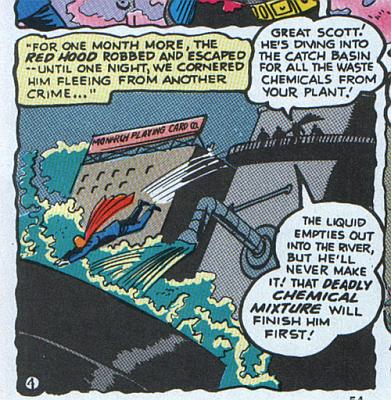

In 1965 Joker and all the other villains disappeared from Batman series for years. The reason? A book called "Seduction Of The Innocent" that had ridiculous claims and accused comic books of promoting violence and all kinds of stuff. Because of that, comic book sales suffered tremendously and a new tactic had to be taken. Batman was now fighting with outlandish creatures from space, some aliens, invisible people, creatures from other dimensions, giant robots, dinosaurs etc, and the action was rarely set in Gotham. This way no one could say that children imitate the action or the villains because the stories and characters were so unreal. And that continued for almost a decade until the mid 60's!
1950's were also the last time we've seen Bob Kane and Bill Finger at helm.
-------------------*1960's*-------------------


The Joker character was very consistent. This is the third decade where you couldn't really tell the difference with other decades because there weren't any. Joker was already one of, if not the most recognizable supervillains and the most known, iconic image of a crook prankster was already in public's mind for three decades at that point.
So the 60's didn't bring anything new to the story except for the Crime Prince's return, although this time different writers and artists took the wheel.
The decade proved to be very important for the character. It was the first time Joker graced the silver screen, in both live action movie, TV series and cartoon.
TV SERIES
Batman TV series debuted in 1966 and was an absolute and unexpected smash hit right away. Joker was portrayed by Cesar Romero in 18 episodes and in a live action movie from 1966 as well.
Romero refused to shave his mustache so they had to cover it up with makeup but you can clearly see them even concealed by the white paint.
This was a big thing because it was the first time someone played Joker and the first time the clown of crime appeared onscreen.
Character-wise, he was spot on and portrayed Joker perfectly, cackling all the time, acting a bit like Duffy Duck and committing silly crimes, like turning the water supplies into jello!
But visually, he was a complete mismatch. As to why, I have no clue since all the other villains are the exact replicas of the comic book versions. Yet Joker is nothing like it - His suit is carrot like instead of purple, his hair seems orange one day and yellow the other instead of green

And the worst - Joker's signature inhuman grin is just cheaply faked with a lipstick, and the ever present heavy laugh lines are almost nonexistent. In addition to that, sometimes he was seen in a Robin-like mask which he never ever had in comic books. Changes sometimes are necessary, but not the changes that leave the character far behind its original version and fall short of expectations.
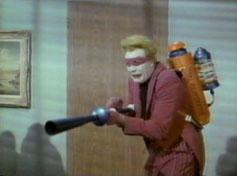
It's most unfortunate that the first time Joker graced the screen he looked nothing like himself and the physical portrayal is neither faithful to the original, nor interesting.
He did however, had most of Joker's signature gadgets like the utility belt for example

Probably the problem was the fact that others were regular people in costumes, while Joker was more of a hideous deformed freak - something you cannot do with cheap special FX and the TV budget
CARTOON
1968 saw the debut of a Batman cartoon, first series out of many. This cartoon series, which continued for years and was later evolved into "The New Adventures Of Batman and Robin" was basically a comic book onscreen. It was 100% faithful and accurate in both visuals and performances of all the characters.

Same writers and artists later went on to do the "Super Friends" cartoon, in which Joker also starred but only in one episode, so he was more of a guest villain. I always found it weird that they haven't choose Joker to be a part of the Legion Of Doom.
-------------------*1970's*-------------------


While 60's provided Joker with his onscreen debut in cartoons and on film, 70's were as important but for a different reasons.
The 70's brought one change almost immediately. Joker was always portrayed as a thin, slim person but now he was a walking toothpick! His character has not changed though. He was still the same prankster he was since the early 40's. It was already a 4th (!) decade for both Batman and Joker, and while Batman went through two massive changes since his first issue (one in the mid 50s, second one in the mid 60s), the iconic super villain remained the same.

Joker in the midst of a 'crime'
But another change was coming, and this time for both of them.
1973 brought major changes in Batman's world. For the first time since 1939, Batman was "the dark knight'. The stories took on a much more mature level and the overall feel became very dark and serious, happening only at night. Joker doesn't change except for one crucial thing - he is a murderer now, and he doesn't commit the kindergarten crimes anymore.
And also, the classic motif of a 'death smile', the result of Joker's poison, returns.

In May 1975, Joker actually got his first comic book! I tried to find out, but I couldn't confirm it, so correct me if I'm wrong, but I believe he was the first villain to get his own monthly publication!

There were some interesting stories there and one of them even co-starred Lex Luthor. The series ended in October 1976, which is relatively short run but it's still VERY good for a comic book devoted fully to the villain!The writers were also instructed to have Joker loose in every single issue since he's a bad guy.
Despite the changes in the comic books, the overall iconic image and characterization of Joker in other media did not change. It is of course, not that simple to alter what's been established for close to 4 decades!
While in the comic books Joker was running around feeding sharks with people, in cartoons he was still a small time criminal doing relatively little pranks. Joker appeared in one episode of Super Friends in the same form as he did in the previous Batman cartoons, and most notably, he appeared in 'Scooby-Doo Meets Batman and Robin" special. There, he and Penguin are dressed as wood ghosts and trolls trying to scare and freak out people passing the forest. They're also trying to get a special suit that allows you to fly. It's also interesting to note that Joker's voice was somewhat similar to Fred Flinstone's, deep and low and with a little lisp.
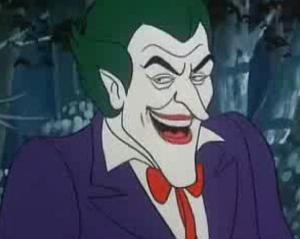
Joker in Scooby-Doo, 1972
By the end of the 70's some weight was restored to Joker, and he left the decade looking like this

---------------------*1980's*---------------------


The 80's further explored Joker's psyche and homicidal tendencies and made him a true psycho worthy of David Fincher movie. The 80's were probably the most revolutionary to the Batman comic book. The darkness, maturity and serious tone reached its peak and stories were often filled with very deep psychological stories. It was the first ever reboot of the franchise with the "Crisis On Infinitive Earths" series, the first ever since the character's inception!
Of course just like with Batman, the look never changed since that's an already established iconic image, but the inside was changing plenty. Here's a great example of Joker's sick humor mixed with his cruelty
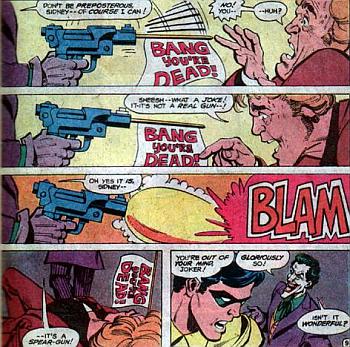
It was in 1988 when Joker's cruelty and evilness was pushed even further: He brutally killed Robin repeatedly hitting him with a crowbar in "Death In The Family"
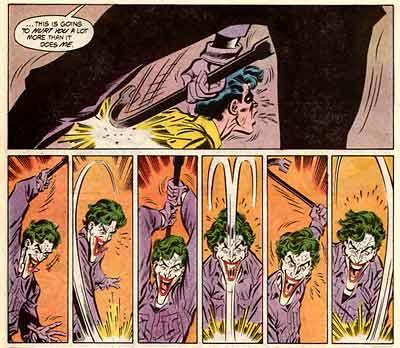
One of the biggest milestones for Joker was "The Killing Joke". A very depressing and thought provoking psychogical tale that revisits and updates Joker's origins. Just like Bob Kane originally presented it in '51, the new age Joker was a villain named Red Hood who fell into the chemicals that bleached his skin, hair and deformed his face. But there's more to it. Originally he was a good caring guy who couldn't get the ends meet and couldn't provide for his pregnant wife. Gangsters get a hold of him and offer him a lot of money if just for once he'll help them out rob a factory, dressed as Red Hood. Just before he's about to do it he finds out his wife was in an accident and died. Still, there's no going back so depressed and frightened he proceeds as planned but Batman intervenes and he jumps into a river full of chemicals.
It is also important to note that the flashbacks are more as a separate story, since Joker admittedly doesn't remember anything from his pre-fall days


The updated origins were told in detail by The Killing Joke. They're still relevant today, shown here in a short recap published very recently
The Killing Joke also shows Joker kidnapping Comissioner Gordon and paralyzing his young daughter Barbara. He then takes off her clothes and takes pictures which he then shows Gordon to push him over the edge.
Another crucial comic book is The Dark Knight Returns and also Year One. Those two gave the Batman series an even darker tone and made sure that people know what this series has become
Joker's homicidal act was really the only, yet crucial change. Also, the Jokermobile and the Jokerplane were use less often, as was the utility belt, although the core accessories like hand buzzer and laughing gas naturally had to stay.
Here's a scene from Killing Joke nicely showing two things: the use of some of Joker's ever present gadgets and his new addition - the psychosis. Here we see Joker talking to a dead guy he just killed

Of course the theme of a smiling poisoned people was now constantly present. A nice nod to the first story.
THE 1989 MOVIE


1989's Batman was the most revolutionary event for Batman that set both him and Joker high on the pedestal once and for all and secured Batman as a major blockbuster series. It also pushed the envelope as far as it was possible at the time. Superhero movies were at the time B movies with low budget and spandex and PG rating at highest (Captain America anybody?). Some were outraged that Batman is so dark and that he doesn't wear blue spandex but black armor and mascara instead.
But let's focus on Joker. Even before the script was written, even before Tim Burton joined in, Jack Nicholson was the one and only choice for the role. He was and still is today, the most achieved and successful actor, having the most Oscars and most nominations of any actor in history and being on both covers of People and Time!
The idea here was to portray the then-and-now-current comic book Joker as faithful as possible.
Visually, he is the 100% perfect reflection of the comic book - the EXACT same gangster outfit (check out any panels below) completed with same hat, pointy eyebrows, purple eyeshadow, heavy laugh lines and the permanent, unnatural smile, in the movie caused by a failed plastic surgery trying to repair a shot wound. Truly a grotesque freak

The origins are also incredibly faithfully recreated, but more faithfully to the original Kane/Finger origins. Jack Napier was always a bad mobster who by falling into chemical wastes and becoming disfigured, falls over the edge and became completely insane. The idea and vibe of old movie gangsters is also present.


Jack Napier
Everything was done very carefully according to the comic books. Most of the movie is a panel by panel shot by shot recreation of some of the classic comic books from 40's and 80's. The very heavy influence of The Killing Joke is certainly evident too. One of the things contributing to such perfect portrayal (even down to the look of the Joker card) was the fact that Bob Kane himself was involved heavily in the project and flew with the crew to Pinewood Studios were he remained for the rest of the shoot. He is also officially credited as the movie's creative consultant

Another thing that really works is the contrast Joker is in this movie. Everything is black and dark, yet he's so colorful but still more repulsive than anything else, and the surroundings are very dream like, especially Grissom's rooms.
Personality wise, it's another bullseye. The Duffy Duck prankster is there, as well as complete insanity and unpredictability and constant jokes. The ever present laugh is of course mandatory. He killed his henchmen and best guy just because! And he also talks to the corpses and pictures, a cool nod to The Killing Joke.

note the contrast of colors
THE GADGETS
The signature gadgets are present too - the fake pistols, acid spitting flowers and killing hand buzzer.
He is a mirror reflection of the comic book Joker character, the rebooted 80's version.
The Chopper

Note the Joker logo on the side - another nod to the roots
The Hand Buzzer

The Orchid


Note the Joker logo on the side - another nod to the roots
The Hand Buzzer

The Orchid

There were also more gadgets like boxing glove, jack'n'the box, flag pistols and joker cars
And just like for the 80's reboot version, money wasn't the goal. He didn't have one. He just did what he did because he was crazy, for no particular reason he tried to wipe out the entire city with his poisonous Smilex gas.
And what's really great is the return to the roots and the inclusion of smile inducing killer gas!

There were two subtle additions to the personality thought. Narcissm - a novel idea and a brand new characteristic for Joker, was one of them. The other one was passion for art...art of death that is. He loved decaying bodies and considered it an art. I was always creeped out by the scene where they showed Alicia's face all messed up and scarred from who knows what he did to her. She was just a sketch as he put it.

"She's just a sketch"

"I am the world's first homicidal artist"
The ending is also a nice nod to the first Batman issue with a faithfull panel recreation

One major element was added to Joker's backstory, which was a very brave and big movie. As it's usually the case with major Hollywood adaptations, some things are merged together so one movie can tell it all and so there's more cohesiveness. While originally, it was a crook for hire Joe Chill who killed Bruce Wayne's parents for mobster Lew Moxon, here it was a young Jack Napier/future Joker who kills Waynes in simple robbery, aided by young Bob The Goon. This way the fiht against Joker was personal.

Young Jack
And here's a good moment to mention Bob The Goon - Joker's first ever sidekick. Bob was as faithful as it's possible to his boss, despite seeing an obvious madness in him and that it's not the same Jack he knew for years. Watching the movie more carefully I noticed a sign of grief and sorrow on Bob's face while watching Joker talking and laughing. The movie's much deeper than one might think. I think Bob was feeling for Jack and what happened to his mind after the accident

Joker and Bob The Goon
Jack delivered a terrific performance as always, wowing the audiences around the world. He was IT at the moment and media, fans and casual viewers couldn't stop praising his performance.
Unfortunately, at that time scifi and even more so superhero movies were never taken as a serious candidate for any awards and were always getting omitted in every department except for FX and art. Still, Jack managed to get a Golden Globe nomination, which for those times was really something for movie of this genre.
Batman and Joker especially graced the covers of so many magazines around the globe. To this I haven't seen anything like that.
Parents and some viewers were shcoked and outtraged at this portrayal of both Batman and Joker. People had in mind the blue TV series Batman and never expected that. Doing a research, I found out that children under 16 were not allowed to see the movie in Belgium and Ireland, because it was deemed that the Joker's character was too much for young viewers.
Personal perspective:
Batman (1989) is where I joined the fun. I was 5 at the time and to this day I think it was the most hyped movie I've ever witnessed. Well, this and T2. The hype was enormous and before that movie I have never seen or heard the term superhero, or even a comic book before. Same with all the other kids. Once we became fascinated with Batman, seeing commercials every hour on TV and Making Of Featurrettes in the evenings and tons of interviews with Burton and Keaton, we became fascinated with comic books overall.That's what started it all for me - the love for comic books, and most importantly, the love for sci fi and movies.

The Comic Book Adaptation - my first comic book
The movie was so Gothic, Operatic and extremely weird, and totally American by an excessive American director. Joker for me was even more fascinating than Batman because he was just so weird and so out of this world. Everything about him was surreal, mysterious and plain weird. But at the same time, you felt sorry for him in some small way - you knew that he was sick and pushed over the edge, and when that delicate lullabye melody plays when the camera zooms on him showing him dead after the fall, some may even shed a small tear.

---------------------*1990's*---------------------


Joker entered the 90's and no further additions were made. The new incarnation of Joker insane killer was now defined by Tim Burton's peculiar Gothic tale and by Nicholson's iconic performance. The image of Joker in general public's mind was now that of a murderous prankster, with the old harmless thief completely wiped out of the consciousness.
Because of the success of Batman, the sales of comic books really picked up and also many European markets started to publish the series based on the movie's popularity. Joker was now naturally appearing regularly, not that he wasn't before.
One of the most notable stories of the 90's is Images, by Dennis O'Neil and Bret Blevins. Since the franchise's reboot in the 80's, the original story with Joker was never retold untill Images. It was a special anniversary issue retelling the story of the first meeting between Batman and his arch enemy.
THE ANIMATED SERIES
The 1989's Batman spawned something more though - the fantastic Batman: The Animated Series by Bruce Timm. Many fans say that this is actually THE most faithfull portrayal of the Joker. While Nicholson basically was a Joker and was his perfect recreation in every possible way, he did have the two additions: narcissm and artistic side. The new animated Joker didn't have two two additions so that was that slight advantage in accuracy.

The Animated Series was a spinoff to Burton's movie, using the same music, Gothic theme, art buildings and 1940's style. Mark Hammil, who played Luke Skywalker in the Star Wars series, was Joker's voice and to this day is praised as the best Joker yet. Hammil did such a great work with Joker that from then on he was offered tons of voice roles in cartoons.


Joker also appears in the popular animated movie "Batman: Mask Of The Phantasm" where it's revealed that he was once a hitman for a known mobster, and that his real name was - just like in the movie - Jack Napier who wants to rob Ace Chemicals factory but encounters Batman and jumps into chemicals.

Jack Napier, the hitman
Even for a cartoon, the series was really serious and powerful. In one episode, "Joker's Favor", a poor man promises Joker to do anything if he will let him live, and then Joker calls him up years later and says that if he won't comply his whole family will be dead. We then see a shot of mobsters driving around his house while his son is playing. Pretty serious stuff, especially for a cartoon!
Just like in the movie, Joker had a sidekick. But this time it was a young girl, going by the name Harley Quinn. extremely loyal and completely in love with Joker, Quinn was always at his side doing whatever it took to make her boss happy. The Animated Series was so popular that her character was then incorporated into the comic books, and eventually she got her own comic book and her characters appeared in the TV series called Birds Of Prey, played by Mia Sara

Joker and Harley Quinn
Personal memories:
When this show debuted, it was like nothing else! I couldn't believe how dark and realistic it was, and loved the fact that it wasn't another cartoon, but a cartoon with the Tim Burton feel. I always took it as a continuation of the movie, even thought it's not exactly so. Most of the characters and their origins are the same (even Penguin is still a deformed bird-man looking exactly like the Returns DeVito version), and the music and Gotham and the overall look is the same, but it's like the events in the movies never happened.
I love the feel and weirdness of that universe. There's a lot of mystery here, and you could never predict what you're gonna see in the next episode.
---------------------*2000's*---------------------


The success and the echo of the Burton's vision by that time almost completely faded away, diluted by the neon, colorful portrayal of Batman's universe by Joel Schumacher. Batman as a movie franchise was dead because of 'Batman & Robin', which brought the franchise back to the 60's TV image
The comic series continued on, and as the times changed and comic books were considered more as a written and illustrated art form for adults rather than stories for children, more and more things were allowed and today there are basicaly no limits.
Ever since the 80's reboot, it seemed like Joker cannot get any more violent or psychotic, but the new, limitless millenium proved otherwise. Use of Joker's gadgets was extremely limited now, and the new areas of homicidal madness were explored, introducing the new boundaries of cruelty.

The murder of Gordon's wife
Joker's origins were also once again revisited. The basic story remained the same throughout the history - Red Hood falling into chemicals - but who was he before the fall kept changing. One of the stories expanded on the story presented by 80's Killing Joke and said that the comedian's name was Jack and that his wife was really murdered. There was also another origin story saying that Joker was a high profile mobster
In 2006's Dark detective story, he kidnaps Bruce's girlfriend and confesses to himself that he doesn't want to kill Batman because the two should always co-exist

CARTOONS
Batman Beyond
Joker returns in Bruce Timm's cartoon series Batman Beyond, set in a future where Bruce Wayne is already an elderly man and a young High School student Terry McGinnis has taken over the role of Batman. Joker returns decades after he's been declared dead. "Batman Beyond: Return of The Joker" had some pretty violent and bloody scenes to the point it actually got a PG rating. The most violent and brutal portrayal of the Joker was a sign of things to come

The older Joker
The Batman
Batman returned to the screen in animated form once again, this time in Anime style. It heavily borrowed from Bruce Timm's cartoon, but added its own twist to everything. The problem right away was: how can you outdo Timm's Joker? You can't. It was a perfect adaptation with perfect accuracy, so you cannot out-joker the Joker. There is only one way to go and it's to this time go a different route -instead of adapating Joker into the cartoon, the character was basically redesigned and reimagined from sratch. It was more of a separate character with some minor influences of Joker. The laughing gas and a prankster attitude was there, as were the colors, but that's pretty much it. This Joker moved like a monkey and also fought like a monkey using his bare feet a lot and actually resembled a monkey

The series was actually quite popular and run for 4 years. It was also nominated for Emmy Award. Of course, it wasn't even close to macthing the over the roof success of Bruce Timm's series, but it did surprisingly well nonethless
THE DARK KNIGHT


The history repeats itself, which for me is a pretty weird experience. Once again a movie with Batman and Joker is the most successfull suprhero movie ever, once again it's tearing up the box office and once again the Joker is praised as the best ever. And this time, Heath Ledger is IT. But in modern age of the internet and easy media access, the voices are heard much louder, and it seems that Joker is now the most popular villain of all time after the enormous praise of his latest portrayal. Once again there are people complaining that this portrayal was too brital and should get a higher rating.
Christopher Nolan's Batman movies are something we haven't seen yet before with Batman. This time we see Batman universe being our universe - set in the most realistically portrayed world as possible. The change is due mostly to the change of genre - it is now a crime action drama, and there is no place for fantasy or sci-fi elements
That already calls for changes since Batman from the beginning was the only fairly realistic thing, and it was the villains who were the most fantastic and otherworldly
Based on the success and praise of the 1989 movie, the anticipation of seeing the two again on the big screen was enormous, but it was made clear from the beginning that it's not gonna be the same thing

As was the case with the cartoon, there was no place to go. Jack Nicholson has already portrayed comic book Joker with a perfect accuracy, so it was yet again an idea of trying to out-joker the Joker. And as with the recent cartoon, it was obvious that doing the same thing wouldn't work, it would be just a repeat. Same measures were taken, the idea of a different character based on Joker.
LEDGER: You know, I was a big fan of Jack Nicholson - still am - his portrayal of the Joker was perfect for Tim Burton's world and if Tim Burton had come to me and he was doing the sequel and he asked me to play the Joker in his movie, I wouldn't do it. I couldn't. Because you couldn't touch what Jack Nicholson did. It would be a crime. When Chris came to me, I'd already seen Batman Begins and I really liked it. Because I'd already seen it, I already knew the world, which he had created. I instantly knew of an angle. I instantly knew a way into this character. A way to create a character to fit into this world and so it was fairly immediate.
Decision was already made not to simply portray the Joker. The joker had to get a makeover that would re-do him in a way that he could actually be a real life character. In that case major changes were required, a total reimagination
This version is often referred to as the Grunge version.
As mentioned before, Joker was always this dream like character with surreal appearance. That couldn't make it into the new movie, as it was done before and the concept is now different with realism.
First of all, the whole iconic gangster idea was scrapped. Years and years were taken off Joker, placing him in his early 30's the latest. The flamboyant gangster suit had to go as well, and was replaced with the regular clothes in a more grungy style with key chains and such. The flashy signature colors were heavily desaturated

Basically everything went through a horror treatment. The origins had to be scraped as well. As cool as they were, they were a perfect fit for the fantasy or superhero movies, not for an action drama in the vein of The Departed or Heat (a cited influence on the movie). There were no definite origins given, and just like in Killing Joke, Joker did not remember his past well, nor his name. He was the regular human being though, just like everyone else in this version
For the first time ever, there was no permanent white face. The white skin was heavily tied to origins and naturally for this version had to go as well. Instead, Joker likes to apply makeup on his face in a very loose and lazy way, not caring for outline or details. The result is the makeup being more 'splashed', which also gives him a more horrific look.
The permanent inhuman laugh gets a horror treatment as well. He no longer has a true 'smile' in the same sense. What makes his permanent smile tho, are the scars on the sides of his face, most likely caused by a knife cut. But again, with Joker, he doesn't remember.

Naturally, there were no gadgets at all. There couldn't be. If Joker was to be a real life criminal, we know criminals don't use the Batman type accessories but simple things instead like guns or knives. And it's guns and, to a bigger extent, knives, that become Joker's accessories in this version

And the personality? This had to get some makeover, but not as much as the other areas. The Killing Joke was the main inspiration for that incarnation. Both Heath Ledger and Christopher Nolan admitted that this was their blueprint for Joker. So what's taken from it? A lot. The one thing that immediately jumps at you when you've read the comic book is that Joker doesn't remember his past and has multiple versions of his past in his head. The way he acts and most importantly, the philosophic aspect. In Killing Joke, Joker wanted to prove a point that when pushed over the edge, people will become as crazy as him. That's what he tried to do here too. And just like after the 80's reboot, money had no value for Joker. He just did things, in this case, to prove a point

It wasn't left like that thought. Additions and changes had to be made to the personality as well. Joker was given sadomasochistic characteristics. He actually enjoyed the pain and pain could do nothing to him. He laughs even more when Batman hits him harder. In this version, joker is a terrorist promoting Anarchy. With fear and terrorist attacks, he successfully terrorizes the entire city causing an evacuation.
He is also the first incarnation of Joker that doesn't care for his own life

In The Dark Knight, Joker experiences a different kind of insanity than the comic book Joker. He isn't a prankster. He doesn't joke or laugh all the time. He doesn't have that Duffy Duck side to him. He is completely insane and out of his mind but in a different way - for him everything is a game that has no real purpose other than careless fun. He has absolutely no remorse or limits, and he does get furious at times.
Another characteristic added is sadism. He admittedly enjoyed killing people off as slowly as possible, toying with them
Another aspect that went through the horror treatment was the death smile. Obviously, the poisonous gas causing a grotesque smile couldn't make it to that version, but Joker still leaves smile on his victims faces in two different ways. By simply drawing the smile with the makeup, or by doing the job with a knife

"Let's put a smile on that face"
The story of the Dark Knight heavily borrows from the story of the very first Batman issue. That's what the filmakers meant by saying that they're going back to the roots. Joker announcing their victims and killing them off as promised. The goal is different though. He doesn't care about diamonds
And the one last thing to add: the relationship with Joker and Batman. The conversation at the police station is somewhat very similar to the one from The Killing Joke with Joker explaining that in some ways, they're the same and went a different route than other people. This theme was used quite often throughout the 80's when the comic books took on a really serious route

Personal perspective:
First I was very surprised and shocked that they were going to include the Joker. Throughout the history, we've been proven that once a megastar plays a character that becomes classic and iconic, an unknown name in the remake usually falls incredibly short. But I opened my mind once I realized the premise: it wasn't to repeat the role, it wasn't to play the same guy that is such an iconic pop culture character. It was to create something different, a completely new take and version of the Joker. And it worked just as good. Heath Ledger already received a Golden Globe and Oscar nomination for this role, nowadays when Academy Award recognizes the genre as much as any else. And the take was extremely enjoyable and, as I call it, a horror version of the Joker. Even thought 2008's Joker is not much like the Joker I know and the Joker everyone knows and learned to know and love, he is still a one very interesting and intriguing character on his own, and the phenomenon that surrounds this new version speaks for itself.

Joker has always been my favorite supervillain ever since I saw the 1989 movie. I hope I did the character justice and I hope you enjoyed the article and learned something new about the very long and glorious history of the Joker

65
Login To Vote!
More Articles From Achilles













Comments
43